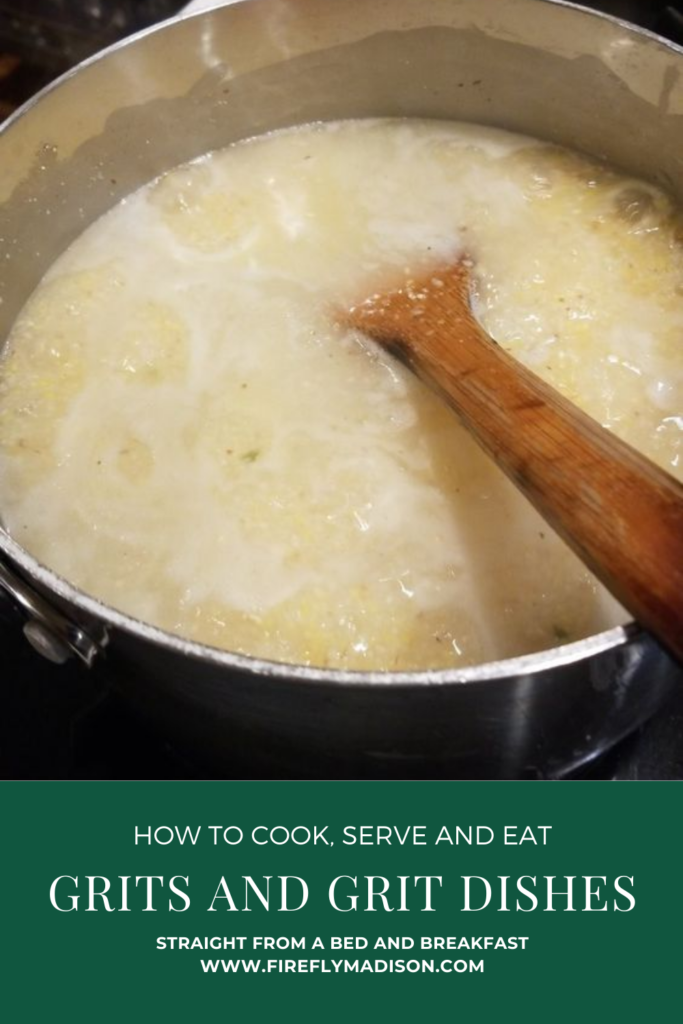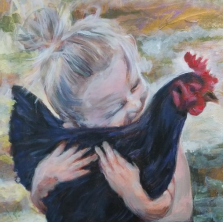
We have to say something about how to cook, serve, and eat grits. This is because grits are occasionally on the breakfast menu here at the Firefly. It is also because we get a lot of visitors from Europe and California who might not be tuned into grits as a comfort food.
What are they?
Grits are reconstituted, boiled corn meal. They are commonly served as breakfast, in the same way as “porridge” which nobody in the US eats.
Origin
Grits were originally given to the white man as a trick by the local Native American population, and as advance punishment for conquering them and moving them out of their lands.
This food was originally introduced to European settlers in 1584, to the original surveying party for the Roanoke colony. The Roanoke Colony, of course, starved out and the survivors completely vanished before 1590. This food was offered to the original English settlers in Jamestown in 1607, but most of them made it.
This low-cost, readily preserved food became a staple food in the region between Texas and Washington DC. This region has become known as the “grits belt” and the epicenter of it is in South Carolina, in which it became a favorite. Learning to cook, serve and eat Grits is an important part of survival in this area.
Importance to local culture
In 2002 Grits became the “official prepared food in the state of Georgia” however implausible that seems. Why does anybody need an “official prepared food?” In fact, Georgia is the only state with one.
https://statesymbolsusa.org/symbol-official-item/georgia/state-food-agriculture-symbol/grits
Grandma
According to this reference, your way to cook, serve and eat grits depends a lot on how your Grandma regarded them. In an era where people aren’t routinely in touch with Grandma, there is a gap in this generational exchange of culture.
If your grandma was Italian, she may have been more familiar with Polenta, which is basically the same thing, ground from a different type of corn. Also, grandma had a lot of time on her hands, in that either grits or polenta take about 45 minutes to cook, although according to this reference:
“Grits” are actually more desirable to make and/or fry up because the texture is not as coarse, and because “grits” per se are ground from “hominy corn.”
Cheap Food for the Poor
According to this reference, grits started out as a cheap food. The hardscrabble farmers in the region used them as a staple while the region was economically underdeveloped.
The Journal of the American Revolution talks about grits as a slave food:
The accepted historical method to cook, serve and eat grits is mainly to boil them in water, with a little salt, until they reach the least undesirable texture. Grits were introduced to the slaves as a food of last resort. Grits were re-introduced to the slave holders for exactly the same reason, with some tasty embellishments.
Grits on TV
in “Alice” there is reference to grits as something that is kissable. This was in the early, innocent days of television. If the show was produced today, they would just use the word “posterior” and call it good.
in the 1992 movie “My Cousin Vinny” the preparation of grits is used as evidence in a trial. Have we told you that some of the scenes from “My Cousin Vinny” were filmed very nearby?
https://www.exploregeorgia.org/things-to-do/list/my-cousin-vinny-film-tour
Grits as Animal Food
This article says it is basically okay, but not necessarily easy, to cook and serve grits to your dog. Why a carnivore would eat grits in the first place is questionable. However, if cooked with enough cheese and butter, and potential meat and meat by-products, you might be able to convince a canine to eat them.
https://www.rover.com/blog/can-dog-eat-grits/
This scientific article states that feeding your chickens grits instead of corn does not especially hurt them any more than feeding them regular corn.
https://www.sciencedirect.com/science/article/pii/0377840188900223
Waffle House Grits
Something needs to be said about this. The Waffle House road trip is still pending. The forum thread below basically talks about the range of opinion in regard to Waffle House Grits.
https://www.secrant.com/rant/off-topic/waffle-house–how-do-you-do-your-grits/59202445

Per the above map, the Waffle House overlaps “Grits Territory” almost precisely. There is plenty to say about Waffle House as an idea, rather than a place. Waffle House method to cook, serve and eat grits are many peoples’ lone idea of the concept and there is some disagreement in this area even among natives as to whether it is worth the effort, versus the hash browns.
Upscale Food for Foodies
According to this reference, as traditionally southern dishes have migrated throughout the country, grits now commonly appear on the menu in “upscale” southern cooking. The main thing about grits is that they are essentially tasteless, and can be embellished with all sorts of different ingredients, and served as a savory food. The most popular of these would be shrimp and grits, which originated in the South Carolina low country. This in combination with typical New Orleans spice combinations makes a very nice high-value dish that can be enjoyed even if you are snooty. We are still trying to cut down on the “snooty” at our place.
So how, now about the use of Grits as breakfast food?
https://www.thespruceeats.com/breakfast-grits-southern-comfort-3057184
It looks based on this research that you have to come to grips with the central question about how to cook, serve and eat grits, which is whether they should be served sweet or savory.
Sweet vs. Savory
According to this reference, the issue of sweet versus savory grits is generational, and based on where your family was from, with mainly people from Louisiana and Alabama favoring the “way that mom cooked them” which was savory.
Grits for Breakfast at the Firefly
At the Firefly, pretty bed and breakfast not far from Atlanta, grits are a frequent breakfast option. Keeping in mind that this place is very near the dark red splotch near Atlanta, and in the heart of the grits belt, this is important. Learning how to cook, serve and eat grits may be an upcoming seminar.
At this place, the question of instant versus regular, and sweet versus savory have come down on the side of regular and savory.
Cooking Instructions


Ingredients:
Grits (from a bag, and not a box)
Egg (at least one)
Cream Cheese four ounces per pot (more is better)
Other ingredients, include spinach, kale, sautéed sausage, onions, garlic and anything fun that might go well in polenta.
Measure half a quart jar of dry grits and stir into “a pot” of boiling, salted water.

Turn down heat, allow to simmer stirring often.
Throw in egg, cream cheese, spinach, kale, or other ingredients you may find around the place. Stir gently while embellishing your grits.
Sausage and Onions
Sautéed sausage and onions are also fine. Smoked salmon is okay, but not shrimp. Shrimp and grits, at this place, is considered dinner food.
Once this mixture solidifies, and turns into regular grits, you’re just about done. This can be done a long time in advance if need be.
Place the grits in a ramekin dish, garnish with a little cheese, and bake at 350 degrees for long enough for the cheese to melt, and for the guests to sit down. This might be ten minutes or so. Add butter right before serving.
This breakfast is served best in a big country kitchen, with laughter and a cut up loaf of ciabatta bread, and/or some selection of tea.
Mistakes to Avoid: How not to cook, serve and eat grits.
https://www.huffpost.com/entry/grits-mistakes-cheese-photos_n_3989786
According to this article, the first big mistake is using instant grits. Once that pitfall is avoided, the main grits failure modes are to under-season them, starting first with salt, and then trying to re-heat them in an oven using dry heat, which causes tasteless, lumpy grits.
Alternate failure mode: using too small a pan. Since “cooking” grits really means to reconstitute them, they will swell up when the water is added.
This means that if your pan is too small, you may expect your grits to drool out, potentially eating a hole in your floor.
Grits Disposal
Since grits are not considered a hazardous waste, you can presumably dispose of uneaten grits in a regular landfill.
There are chickens in the area who would be happy to have them.
If a chicken eats grits with egg in them, is the chicken being a cannibal? If the chicken then pops out an egg, which is then recycled into grits, is that not the purest form of recycling? Important: Do not confuse “feeding grits to the chickens” with “feeding grit to the chickens”. Grit is little pieces of sand that are important to digestion, since chickens don’t have any teeth. Feeding them grits without grit is not recommended.
Side question: If you fed enough grits to a chicken, would its stomach swell up enough for the chicken to explode?
There are so many questions.
![]()
